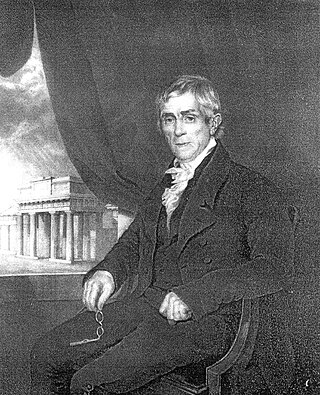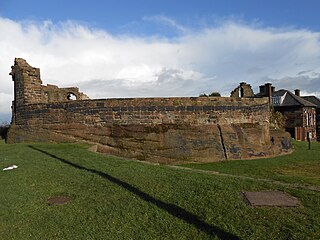
Lancashire is a ceremonial county in North West England. It is bordered by Cumbria to the north, North Yorkshire and West Yorkshire to the east, Greater Manchester and Merseyside to the south, and the Irish Sea to the west. The city of Preston is the largest settlement.

Lancaster Castle is a medieval castle and former prison in Lancaster in the English county of Lancashire. Its early history is unclear, but it may have been founded in the 11th century on the site of a Roman fort overlooking a crossing of the River Lune. In 1164 the Honour of Lancaster, including the castle, came under royal control. In 1322 and 1389 the Scots invaded England, progressing as far as Lancaster and damaging the castle. It was not to see military action again until the English Civil War. The castle was first used as a prison in 1196 although this aspect became more important during the English Civil War. The castle buildings are owned by the British sovereign as Duke of Lancaster; part of the structure is used to host sittings of the Crown Court.

Chester Castle is in the city of Chester, Cheshire, England. It is sited at the southwest extremity of the area bounded by the city walls. The castle stands on an eminence overlooking the River Dee. In the castle complex are the remaining parts of the medieval castle together with the neoclassical buildings designed by Thomas Harrison which were built between 1788 and 1813. Parts of the neoclassical buildings are used today by the Crown Court and as a military museum. The museum and the medieval remains are a tourist attraction.

The West Derby Hundred is one of the six subdivisions of the historic county of Lancashire, in northern England. Its name alludes to its judicial centre being the township of West Derby.

Lancashire is a county of England, in the northwest of the country. The county did not exist in 1086, for the Domesday Book, and was apparently first created in 1182, making it one of the youngest of the traditional counties.

Thomas Harrison was an English architect and bridge engineer who trained in Rome, where he studied classical architecture. Returning to England, he won the competition in 1782 for the design of Skerton Bridge in Lancaster. After moving to Lancaster he worked on local buildings, received commissions for further bridges, and designed country houses in Scotland. In 1786 Harrison was asked to design new buildings within the grounds of Lancaster and Chester castles, projects that occupied him, together with other works, until 1815. On both sites he created accommodation for prisoners, law courts, and a shire hall, while working on various other public buildings, gentlemen's clubs, churches, houses, and monuments elsewhere. His final major commission was for the design of Grosvenor Bridge in Chester.
Chester Castle is an area around the castle in Chester. It was historically an extra-parochial area and today remains a civil parish, albeit with no inhabitants.
Lindow Woman and Lindow I are the names given to the partial remains of a female bog body, discovered in a peat bog at Lindow Moss, near Wilmslow in Cheshire, England, on 13 May 1983 by commercial peat-cutters. The remains were largely a skull fragment, which was missing its jaw, but with soft tissue and hair attached. The remains were subsequently dated to the Roman period. The remains became more technically known as Lindow I after the discovery of other remains in the same bog, which were identified as Lindow Man or Lindow II in 1984 and Lindow III in 1987.

Halton Castle is a castle in the village of Halton, part of the town of Runcorn, Cheshire, England. The castle is on the top of Halton Hill, a sandstone prominence overlooking the village. The original building, a motte-and-bailey castle began in 1071, was replaced with the current sandstone castle in the 13th century. Building alterations continued until at least 1609, when the structure is recorded as in disrepair. The castle is recorded in the National Heritage List for England as a designated Grade I listed building, and a scheduled monument.

St John the Evangelist's Church is in Walton, Warrington, Cheshire, England. It was built as a private estate church towards the end of the 19th century but is now an active Anglican parish church in the diocese of Chester, the archdeaconry of Chester and the deanery of Great Budworth. The church is recorded in the National Heritage List for England as a designated Grade II* listed building.

The Queen Elizabeth II Law Courts, in Derby Square, Liverpool, are operated by His Majesty's Courts and Tribunals Service. The building is used by the Crown Court, the Magistrates' Court, Liverpool District Probate Registry and the Liverpool Youth Court.

Preston Crown Court, or more properly the Crown Court at Preston, is a criminal court on the Ring Way in Preston, Lancashire, England. The court is based on two sites in the city; Preston Combined Court Centre on Ringway and Sessions House on Lancaster Road. As a first tier court centre, the court deals with all types of cases that are heard in the Crown Court as well as being a trial centre for civil High Court cases; it is also a venue for the County Court where smaller civil cases and family cases are dealt with.

The Statue of Queen Victoria stands in front of Chester Crown Court in the forecourt of Chester Castle, Chester, Cheshire, England. It was unveiled in 1903, the sculptor was Frederick William Pomeroy, and the statue is recorded in the National Heritage List for England as a designated Grade II listed building.

St Nicholas Church is an active Anglican parish church in the diocese of Chester on Newport Avenue, in Wallasey, in Wirral, England. It was designed by J. F. Doyle and built in 1910–11. The church is located near Wallasey Golf Club and is known as the Harrison Memorial Church or the Golfers' Church. It is recorded in the National Heritage List for England as a designated Grade II listed building.

Truro Crown Court is a Crown Court venue which deals with criminal cases at Edward Street in Truro, Cornwall, England. It is a Grade II* listed building.

Reading Crown Court is a judicial facility in Reading, Berkshire. It is a Grade II listed building.

County Hall is a former municipal building on Castle Drive in Chester, Cheshire, England. It was the headquarters of Cheshire County Council and is now the Wheeler building campus of the University of Chester.

Mold Law Courts is a Crown Court venue, which deals with criminal cases, as well as a County Court venue, which deals with civil cases, in Raikes Lane, Mold, Flintshire, Wales.

The Sessions House is a judicial structure in Toft Road, Knutsford, Cheshire, England. The structure, which used to be the main courthouse for the eastern part of the county of Cheshire, is a Grade II* listed building.


















